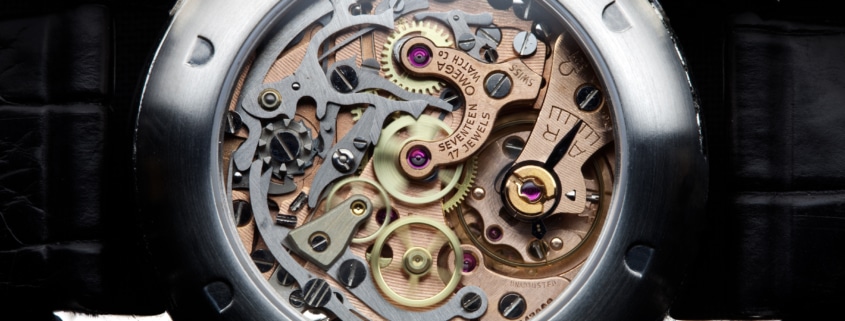Why Do Watches Have Jewels in the Movement

The relationship between watches and jewels is a deep, intricate one. Of course, watches can be considered pieces of jewelry, especially as in today’s times they are no longer a necessary time-keeping accessory. You may not realize it, but inside your watch vintage there are jewels in the movement.
The functionalities of a watch might have been replaced by our mobile phones, but we still can’t do without a nice watch on our wrist. In fact, watches can be a sophisticated, beautiful accessory adorned with precious stones, rare metals, and luxurious dials enclosing delicate and precise mechanisms.
However, the jewels on a watch are not only there for aesthetic reasons, and they are not only used to decorate the hands, case, dials, or straps. A quick look at the movements of your classic or vintage watch will tell you that jewels are right at the core of the watch’s mechanism.
In fact, for generations, watchmakers leveraged the unique properties of jewels and precious gemstones to make the movements of a watch even more precise and long-lasting.
Here is all you need to know about the gems embedded in your watch’s core.
Understanding the Different Jewels In Watchmaking
If you are new to watchmaking and you are wondering about the gemstones in the movements of your watch, you might also be wondering about the different numbers that describe the jewels. For example, your watch might show numbers such as 7, 17, 21, etc.
In fact, if your watch is an older one, it is common for the watchmaker to have specified the number of jewels used in the creation of the movements. In older models, these numbers can be found on the dials. However, if you have a newer model, you might find them on the movement themselves.
This change that has happened over time gives us a clear indication of the value that the gemstones used in the creation of the watch held throughout time. Because of this value, some watchmakers started to introduce up to 100 gemstones in the watch movements, something that increased the value of the watch but did not improve its functioning. Today, only functional jewels can be embedded in the movements.
What Are The Jewels in The Movement For?
Now you know that it is normal for older watches to have jewels in their movements, let’s have a look at why these gemstones have been embedded in the delicate core of a watch. Firstly, the jewels in a watch are referred to as jewel bearings, they are flat and cylindrical, and they house rotating gear.
Some other stones might be found in the escapement components of the watch and they play an important role in defining the movement of the watch itself.
In the past, watchmakers have used rare and precious stones to increase the quality and value of the watch. Some of the most common stones used in a watch’s movements include:
- Diamonds
- Sapphires
- Rubies
Depending on the watchmaker’s taste and availability, both natural stones and synthetic derivatives of corundum were used. However, all of these were selected for their hardness, which puts them high up on the Mohs Hardness Scale.
The use of these stones in watchmaking is not born out of aesthetic or value-related reasons. Instead, they derive from a necessity that watchmakers had to make their creation last longer and withstand daily wear and tear.
In fact, the functioning of watches relies on their movements, which are usually made of metal. However, as these mechanisms continued to move, metal-on-metal wear and tear happened, which can stop the watch from working correctly.
Jewels, including rubies, sapphires, and diamonds are much harder than metal, and they are able to withstand the corrosive action of metal-on-metal movements. Since watchmakers started to see that using gems allowed them to increase the lifespan and precision of their creation, the whole industry adopted these standards.

Omega 17 jewel hand-wind column wheel screwed balance chronograph movement with 30-minute and 12-hour registers.
Historical vs. Modern Watchmaking
Today, watches have become increasingly precise and long-lasting, and watchmakers have started to replace natural stones with synthetic alternatives. The most common options for today’s watchmakers include synthetic corundum, the look of which is modified by using aluminum dioxide and colorants.
Since these new synthetic materials can achieve the same performance as natural stone while costing a fraction of the price of diamonds, sapphires, and rubies, the watchmaking industry is turning towards this alternative.
How this Plays Out in a Watch Restoration
Considering newer watches have synthetics and vintage watches have real stones imagine how that could play out in restoration. It’s critcal to take your antique timepiece to a restoration shop you trust. You want to ensure if jewels in the movement are missing or need replacement they are replaces with real stones of the right kind. Also you want to know that they didn’t swap your real stones for synthetics.
The Perfect Number of Jewel Bearings
When it comes down to finding the perfect number of jewels to protect and refine the functioning of a watch, there is no set formula that can be used. In fact, the number of functional jewels in a watch depends on how many components require bearings for functioning.
The minimum number of jewels to affordable but efficient movements is 7 jewel bearings. However, the average number of bearings used by modern watches is 21 – but additional stones that match the ones on the movements are often installed in the barrel.
More complex or luxury watches that cover multiple functions can use more than 21 stones, yet these are designed to support additional wheels and levers that are not commonly found in three-hand automatic caliber watches.
How Are Jewel Bearings Used
Jewel bearings are used in a variety of ways within the mechanisms of a watch. Some of the most common uses for natural and synthetic jewels in the movement include:
- Hole jewels or pierced jewels – usually mounted on the wheel’s axle or pivots.
- Cap jewels don’t have holes and are used to minimize the movement of the balance staff
- Pallet jewels are rectangular bearings that are located at the end of the pallet fork’s arms.
- Roller jewels are used as connection points between the pallets and the escape wheel.
Bottom Line on Jewels in the Movement
Some of the most refined watches are still in use today also thanks to the unique manufacturing process that preserved them and helped them stand the test of time. Thanks to the jewels – whether they are natural or synthetic – you can count on knowing the right time for years to come without worrying about the quality and functioning of your watch.
If you are looking for an exclusive piece of watchmaking, look out for the number of jewels in the movement, the way they are positioned, and where they are described – you will learn a lot more than you know now about your watch.





 Our mission is to help people find local watch repair shops and authorized service centers. As avid collectors we understand how to find trustworthy services that can keep your precious timepiece both functional and beautiful.
Our mission is to help people find local watch repair shops and authorized service centers. As avid collectors we understand how to find trustworthy services that can keep your precious timepiece both functional and beautiful. 
